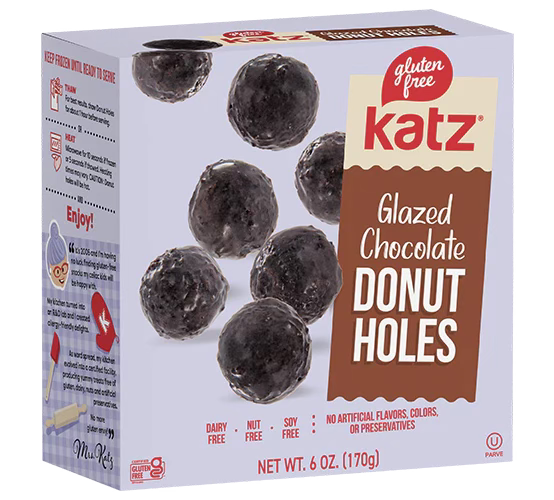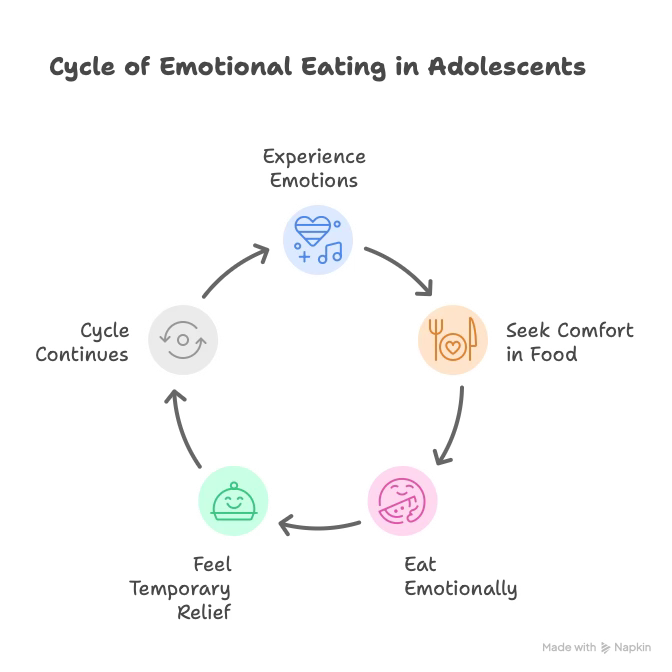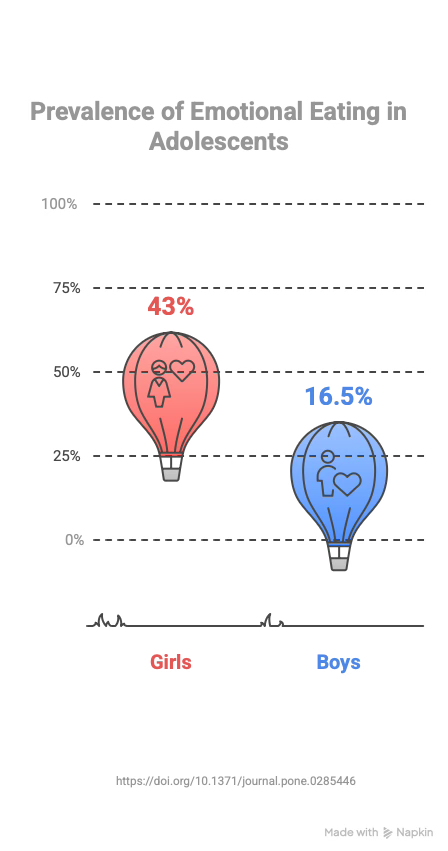Emotional Eating In Adolescents: When Hunger Isn’t About Food
We're finally shining a light on the impact of eating behavior in adolescents. They're struggling, too.

The Seeds are Planted Young
I thought I’d give my kids a special, fun breakfast with gluten-free donut holes and scrambled eggs for some actual nutrients. They were only two and three years old, and hardly ever got sugar… so we were all looking forward to it.
I got them settled at the table, pulled the box from the freezer. It was already open.
😱 And Empty.
I was baffled. It wasn’t like my husband to get into the donuts (he’s got a super human ability to not eat delicious things), but there was no other explanation.
“Sorry, guys. It looks like someone ate all the donuts”
“Who ate them?! Daddy!!” they asked.
I assumed so, too.
As my husband entered the kitchen, I asked if he had eaten the donuts.
“No.”
We were baffled. I didn’t eat them (although it is totally something I would have done, minus leaving the empty box in the freezer).
So how were they gone?
My daughter, at three, hadn’t mastered the art of keeping a straight face…and her expression said it all.
She inherited what I called my mom’s “lying face” … a dead give away every time.
“Did YOU eat the donuts?!” I asked her.
As it turns out, she had gotten up in the wee hours of the morning, tip-toed downstairs, turned on Netflix and ate the entire box of donuts. This one right here:
My 3 year old at an entire box of donut holes?!
More than anything, I was grateful she hadn’t choked while we were asleep! (Then I looked at the box to see how much sugar she consumed … approximately 50g. While that’s a LOT, I figured she’d be fine. After all, that’s about the same as a small Coke… and look how many people drink ‘em daily and are still alive. Somehow.)
Not Again 😩
A couple years later while cleaning her room I found stashes of candy and various food wrappers. Quite a lot. I told my husband and sat on it for a few days before acting.
Doing the work I do, I tread lightly with conversations about food and eating behavior, especially with my kids.
When the conversation finally happened, here’s how it went:
I told her what I had found, and asked her kindly to please not keep food or eat in her room. It will attract bugs, and worse, she could choke and I would never know to help her!
I asked if she kept it in there because she thought I wouldn’t let her have it, she confirmed.
We agreed that she could have these various things to eat whenever she wanted, she didn’t need to hide them!
But, to make sure it didn’t turn into a free-for-all-junk-food-extravaganza in my house, we also had (and still have) regular chats about choosing foods that our body needs, not only what our mouth likes.
Our motto: 😋 nutritious and delicious!
Was it fail proof?
No.
Did it work?
Yes!
By not approaching her with a punishment or making her feel shameful for eating a bunch of bars, candy, and gummies, it didn’t encourage her to continue doing it in secret.
Children and teens, just like adults, are whole persons.
The thing to remember here is that children and teens, just like adults, are whole persons. We all appreciate autonomy in our decisions, even if we’re little and don’t really know the implications of those decisions.
Emotional Eating: Are your kids at risk?
The short answer: YES!
Everyone is at risk, and the risk increases when we have emotional stress that we don’t know how to deal with. When effective coping strategies are absent, food steps in to fill the gap. Then it becomes a habit, the go-to coping strategy when emotions are strong.
Maladaptive eating behavior can begin at any age.
Emotional eating is not only prevalent among young adults–it’s increasingly common in adolescents. New research is showing between ~30-50% of adolescents engage in emotional eating. (The range is wide because as with most new research, studies have different findings)
(If you want to peek at the prevalence in adults, especially associated with obesity and overweight, see this past article.)
Why does this matter? Kids are resilient, they can eat anything!
Nope. It matters. Why?
📣 To state the obvious:
the habits we develop as young adults predict future behavior … and poor lifestyle behavior gets us in bed with chronic disease. Adolescent habits matter.
🧐 Family Life, Activity, Sun, Health, and Eating
What does the research say?
In 2014, The National Cancer Institute conducted a cross-sectional study called “Family Life, Activity, Sun, Health, and Eating (FLASHE),” seeking to understand more about cancer-related behaviors. Researchers have published new work every year using this data. Several are using the data to connect dots between adolescents and emotional eating patterns.
Today I’m just barely scratching the surface as I dig into the findings of one publication: Psychosocial Correlates in Patterns of Adolescent Emotional Eating and Dietary Consumption
Rest assured I’m going to explore more nooks and crannies because THIS MATTERS – for my children, for yours, for our entire society.
The Landscape of Adolescent Emotional Eating
A 2024 publication also based on the FLASHE data (Kidwell et al) says, “Despite emotional eating being a frequent research target, the prevalence of emotional eating in US adolescents is currently unknown.”
We have a massive (and rising) childhood (and adult) obesity epidemic. One of the biggest drivers of obesity sat with an unknown prevalence for this long?! Incredible.
You have to know better to do better … and now we know. No excuses.
A quick reminder, what is emotional eating?
Eating as a coping mechanism, typically in response to negative emotions like stress, sadness, anxiety, or boredom.
Now back to the psychosocial correlates article, and I read: “Nearly 46% of the adolescents in our sample engaged in any emotional eating behavior; approximately 34% of adolescents reported eating while sad and 40% while anxious.”
*It is worth noting that the emotional eating items used in FLASHE only covered sadness and anxiety. Emotional eating is far more complex and any emotions (happiness, anger, boredom, confusion, stress, etc) can trigger episodes.
Related, an older study (2014) referenced from a Finnish population followed from birth revealed stress-related eating behavior was more common among girls (43%) than among boys (15%).
Four Patterns of Adolescent Eating Behavior
The survey data revealed four patterns of eating behavior, pairing diet quality with frequency of emotional eating.
Poor diet/high emotional eating (31%)
Mixed diet/high emotional eating (9%)
Poor diet/low emotional eating (43%)
Mixed diet/low emotional eating (17%)
Dietary intake was assessed by fruit and veg, sugar sweetened beverages, and junk food consumption (by recall over the past 7 day period, which of course isn’t perfect but it’s something).
Emotional eating was assessed by the Absence of Hunger Questionnaire. Participants indicated (on a likert scale) how often they start or continue eating in the absence of hunger, driven by sadness or anxiousness.
While previous studies have established a relationship between high (frequent) emotional eating and energy-dense or sweet foods, these findings provide a bit more nuance.
Interestingly, most participants fell into one of the two poor diet groups (poor diet is now the social norm), but were split between high and low emotional eating behavior.
In addition to dietary patterns, psychosocial factors, demographics, self-efficacy, and motivation all play a role in emotional eating.
There’s a lot to dive into here, so I’ll bookmark that for next week. Stay tuned.
As a Parent, Step Up
You don’t have to wait for my next article or more high powered research to come out to take action.
The first thing you might consider is to simply notice. Take stock of your behaviors, your kids’ behaviors, the type of food available in your home, and the general vibe.
What kind of food is in your home regularly?
Among the options, what is prioritized?
How is your eating behavior? (Our children model everything we do!)
If we are modeling eating packaged foods as we’re on the go, or heading to the pantry every time we’re bored or stressed … guess what they learn?
What is the vibe of your home?
Is it stressful, loud, chaotic? (Beyond what a house with kids generally sounds like)
As parents, we need to set the example for our children with a positive relationship with food. We should be fostering an environment that encourages healthy choices, behaviors, and coping skills that don’t involve food.
Next week, join me as I dive into some more detail on the psychosocial correlates including demographics, self-efficacy, and motivation…and most importantly, what steps you might take to move from noticing to enacting change.








